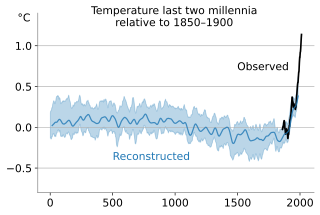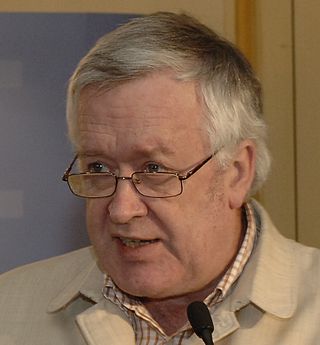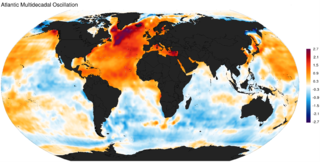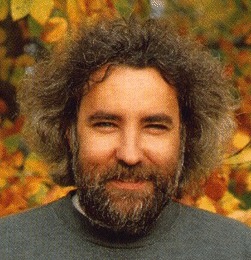Related Research Articles

The temperature record of the last 2,000 years is reconstructed using data from climate proxy records in conjunction with the modern instrumental temperature record which only covers the last 170 years at a global scale. Large-scale reconstructions covering part or all of the 1st millennium and 2nd millennium have shown that recent temperatures are exceptional: the Intergovernmental Panel on Climate Change Fourth Assessment Report of 2007 concluded that "Average Northern Hemisphere temperatures during the second half of the 20th century were very likely higher than during any other 50-year period in the last 500 years and likely the highest in at least the past 1,300 years." The curve shown in graphs of these reconstructions is widely known as the hockey stick graph because of the sharp increase in temperatures during the last century. As of 2010 this broad pattern was supported by more than two dozen reconstructions, using various statistical methods and combinations of proxy records, with variations in how flat the pre-20th-century "shaft" appears. Sparseness of proxy records results in considerable uncertainty for earlier periods.

Michael Evan Mann is an American climatologist and geophysicist. He is the director of the Center for Science, Sustainability & the Media at the University of Pennsylvania. Mann has contributed to the scientific understanding of historic climate change based on the temperature record of the past thousand years. He has pioneered techniques to find patterns in past climate change and to isolate climate signals from noisy data.

Coesite is a form (polymorph) of silicon dioxide Si O2 that is formed when very high pressure (2–3 gigapascals), and moderately high temperature (700 °C, 1,300 °F), are applied to quartz. Coesite was first synthesized by Loring Coes Jr., a chemist at the Norton Company, in 1953.
The metabolic theory of ecology (MTE) is the ecological component of the more general Metabolic Scaling Theory and Kleiber's law. It posits that the metabolic rate of organisms is the fundamental biological rate that governs most observed patterns in ecology. MTE is part of a larger set of theory known as metabolic scaling theory that attempts to provide a unified theory for the importance of metabolism in driving pattern and process in biology from the level of cells all the way to the biosphere.

In the study of past climates ("paleoclimatology"), climate proxies are preserved physical characteristics of the past that stand in for direct meteorological measurements and enable scientists to reconstruct the climatic conditions over a longer fraction of the Earth's history. Reliable global records of climate only began in the 1880s, and proxies provide the only means for scientists to determine climatic patterns before record-keeping began.

Hans von Storch is a German climate scientist. He is a professor at the Meteorological Institute of the University of Hamburg, and Director of the Institute for Coastal Research at the Helmholtz Research Centre in Geesthacht, Germany. He is a member of the advisory boards of the journals Journal of Climate and Annals of Geophysics. He worked at the Max Planck Institute for Meteorology from 1986 to 1995 and headed the Statistical Analysis and Modelling research group there.

The description of the Medieval Warm Period and Little Ice Age in IPCC reports has changed since the first report in 1990 as scientific understanding of the temperature record of the past 1000 years has improved. The Medieval Warm Period (MWP) and Little Ice Age (LIA) are the best-known temperature fluctuations in the last millennium.

Gavin A. Schmidt is a climatologist, climate modeler and Director of the NASA Goddard Institute for Space Studies (GISS) in New York, and co-founder of the award-winning climate science blog RealClimate.

The global temperature record shows the fluctuations of the temperature of the atmosphere and the oceans through various spans of time. There are numerous estimates of temperatures since the end of the Pleistocene glaciation, particularly during the current Holocene epoch. Some temperature information is available through geologic evidence, going back millions of years. More recently, information from ice cores covers the period from 800,000 years before the present time until now. A study of the paleoclimate covers the time period from 12,000 years ago to the present. Tree rings and measurements from ice cores can give evidence about the global temperature from 1,000-2,000 years before the present until now. The most detailed information exists since 1850, when methodical thermometer-based records began.

Hockey stick graphs present the global or hemispherical mean temperature record of the past 500 to 2000 years as shown by quantitative climate reconstructions based on climate proxy records. These reconstructions have consistently shown a slow long term cooling trend changing into relatively rapid warming in the 20th century, with the instrumental temperature record by 2000 exceeding earlier temperatures.

The scientific question of within which larger group of animals birds evolved has traditionally been called the "origin of birds". The present scientific consensus is that birds are a group of maniraptoran theropod dinosaurs that originated during the Mesozoic Era.

The Atlantic Multidecadal Oscillation (AMO), also known as Atlantic Multidecadal Variability (AMV), is the theorized variability of the sea surface temperature (SST) of the North Atlantic Ocean on the timescale of several decades.

The CLAW hypothesis proposes a negative feedback loop that operates between ocean ecosystems and the Earth's climate. The hypothesis specifically proposes that particular phytoplankton that produce dimethyl sulfide are responsive to variations in climate forcing, and that these responses act to stabilise the temperature of the Earth's atmosphere. The CLAW hypothesis was originally proposed by Robert Jay Charlson, James Lovelock, Meinrat Andreae and Stephen G. Warren, and takes its acronym from the first letter of their surnames.

Keith Raphael Briffa was a climatologist and deputy director of the Climatic Research Unit. He authored or co-authored over 130 scholarly articles, chapters and books. In his professional work, he focused on climate variability in the late Holocene, with a special focus on northern portions of Europe and Asia. Briffa's preferred method was dendroclimatology, which is a set of procedures intended to decode information about the past climate from tree rings. Briffa helped develop data sets from trees from Canada, Fennoscandia, and northern Siberia which have been used in climate research.

The Roman Warm Period, or Roman Climatic Optimum, was a period of unusually-warm weather in Europe and the North Atlantic that ran from approximately 250 BC to AD 400. Theophrastus wrote that date trees could grow in Greece if they were planted but that they could not set fruit there. That is still the case today, which implies that South Aegean mean summer temperatures in the 4th and the 5th centuries BC were within a degree of modern ones. That and other literary fragments from the time confirm that the Greek climate was basically the same then as around 2000. Tree rings from the Italian Peninsula in the late 3rd century BC indicate a time of mild conditions there around the time of Hannibal's crossing of the Alps with imported elephants in 218 BC.
The Wegman Report was prepared in 2006 by three statisticians led by Edward Wegman at the request of Rep. Joe Barton of the United States House Committee on Energy and Commerce to validate criticisms made by Stephen McIntyre and Ross McKitrick of reconstructions of the temperature record of the past 1000 years, in particular the reconstructions by Mann, Bradley and Hughes of what had been dubbed the hockey stick graph.
The North Report was a 2006 report evaluating reconstructions of the temperature record of the past two millennia, providing an overview of the state of the science and the implications for understanding of global warming. It was produced by a National Research Council committee, chaired by Gerald North, at the request of Representative Sherwood Boehlert as chairman of the U.S. House of Representatives Committee on Science.

In ecology, a light gap is a break in forest canopy or similar barrier that allows young plants to grow where they would be otherwise inhibited by the lack of light reaching the seedbed. Light gaps form predominantly when a tree falls, and thus produces an opening in the forest canopy. Light gaps are important for maintaining diversity in species-rich ecosystems.

The Medieval Warm Period (MWP), also known as the Medieval Climate Optimum or the Medieval Climatic Anomaly, was a time of warm climate in the North Atlantic region that lasted from c. 950 to c. 1250. Climate proxy records show peak warmth occurred at different times for different regions, which indicate that the MWP was not a globally uniform event. Some refer to the MWP as the Medieval Climatic Anomaly to emphasize that climatic effects other than temperature were also important.
References
- 1 2 Mann, Michael E.; Bradley, Raymond S.; Hughes, Malcolm K. (1999). "Northern hemisphere temperatures during the past millennium: Inferences, uncertainties, and limitations" (PDF). Geophysical Research Letters. 26 (6): 759. Bibcode:1999GeoRL..26..759M. doi: 10.1029/1999GL900070 .
- 1 2 Malcolm K. Hughes publications indexed by Google Scholar
- ↑ "Malcolm Hughes curriculum vitae" (PDF). Archived from the original (PDF) on 29 June 2010.
- ↑ "Abc.co.au – Conversation with Malcolm Hughes". Australian Broadcasting Corporation . Archived from the original on 23 June 2008.
- ↑ "Profile at the Laboratory for Tree-Ring Research". Archived from the original on 6 December 2008.
- ↑ Gaffney, Owen (26 July 2011). "In the line of fire - IGBP". www.igbp.net. Retrieved 28 May 2021.
{{cite web}}: CS1 maint: url-status (link) - ↑ Hughes, Malcolm K. (1969). Investigations of the ecosystem energetics of an English woodland. ethos.bl.uk (PhD thesis). Durham University.
- ↑ "Malcolm Hughes". Senior Vice President for Academic Affairs & Provost. University of Minnesota. Archived from the original on 23 July 2008. Retrieved 5 February 2009.
- ↑ Bradley, R.S., Hughes, M.K. and Diaz, H.F (2003). "Climate in Medieval times". Science. 302 (5644): 404–405. doi:10.1126/science.1090372. PMID 14563996. S2CID 130306134.
{{cite journal}}: CS1 maint: multiple names: authors list (link) - ↑ Mann, M.E. & Hughes, M.K. (2002). "Tree-Ring Chronologies and Climate Variability". Science. 296 (5569): 848–849. doi:10.1126/science.296.5569.848. PMID 11989486. S2CID 13005620.
- ↑ Myneni, R.B., Dong, J., Tucker, C.J., Kaufmann, R.K., Kauppi, P.E., Liski, J., Zhou, L., Alexeyev, V. and Hughes, M.K. (2001). "A large carbon sink in the woody biomass of northern forests" (PDF). Proceedings of the National Academy of Sciences. 98 (26): 14784–14789. Bibcode:2001PNAS...9814784M. doi: 10.1073/pnas.261555198 . PMC 64936 . PMID 11742094.
{{cite journal}}: CS1 maint: multiple names: authors list (link) - ↑ Bradley, R.S., Briffa, K.R., Crowley, T.J., Hughes, M.K., Jones, P.D. and Mann, M.E. (2001). "The Scope of Medieval Warming". Science. 292 (5524): 2011–2012. doi:10.1126/science.292.5524.2011b. PMID 11411490. S2CID 4230106.
{{cite journal}}: CS1 maint: multiple names: authors list (link) - ↑ "Malcolm Hughes". Institute for Environment and Society. The University of Arizona. Archived from the original on 6 December 2008. Retrieved 5 February 2009.
- ↑ Mann, M.E.,Raymond S. Bradley, Malcolm K. Hughes, and Philip D. Jones (1998). "Global Temperature Patterns". Science. 280 (5372): 2027e–2027. Bibcode:1998Sci...280.2027M. doi:10.1126/science.280.5372.2027e. S2CID 122408509.
{{cite journal}}: CS1 maint: multiple names: authors list (link) - ↑ Mann, M.E., Bradley, R.S., Hughes, M.K. (1998). "Global-Scale Temperature Patterns and Climate Forcing Over the Past Six Centuries". Nature. 392 (6678): 779–787. Bibcode:1998Natur.392..779M. doi:10.1038/33859. S2CID 129871008.
{{cite journal}}: CS1 maint: multiple names: authors list (link) - ↑ Hughes, M.K. (1988). "Ice-layer dating of eruption at Santorini.Scientific correspondence". Nature. 335 (6187): 211–212. Bibcode:1988Natur.335..211H. doi:10.1038/335211b0. S2CID 11546512.
- ↑ Hughes, M. K., F. H. Schweingruber, D. Cartwright and P. M.Kelly (1984). "July–August temperature at Edinburgh between 1721 and 1975 from tree-ring density and width data". Nature. 308 (5957): 341–344. Bibcode:1984Natur.308..341H. doi:10.1038/308341a0. S2CID 4336946.
{{cite journal}}: CS1 maint: multiple names: authors list (link)